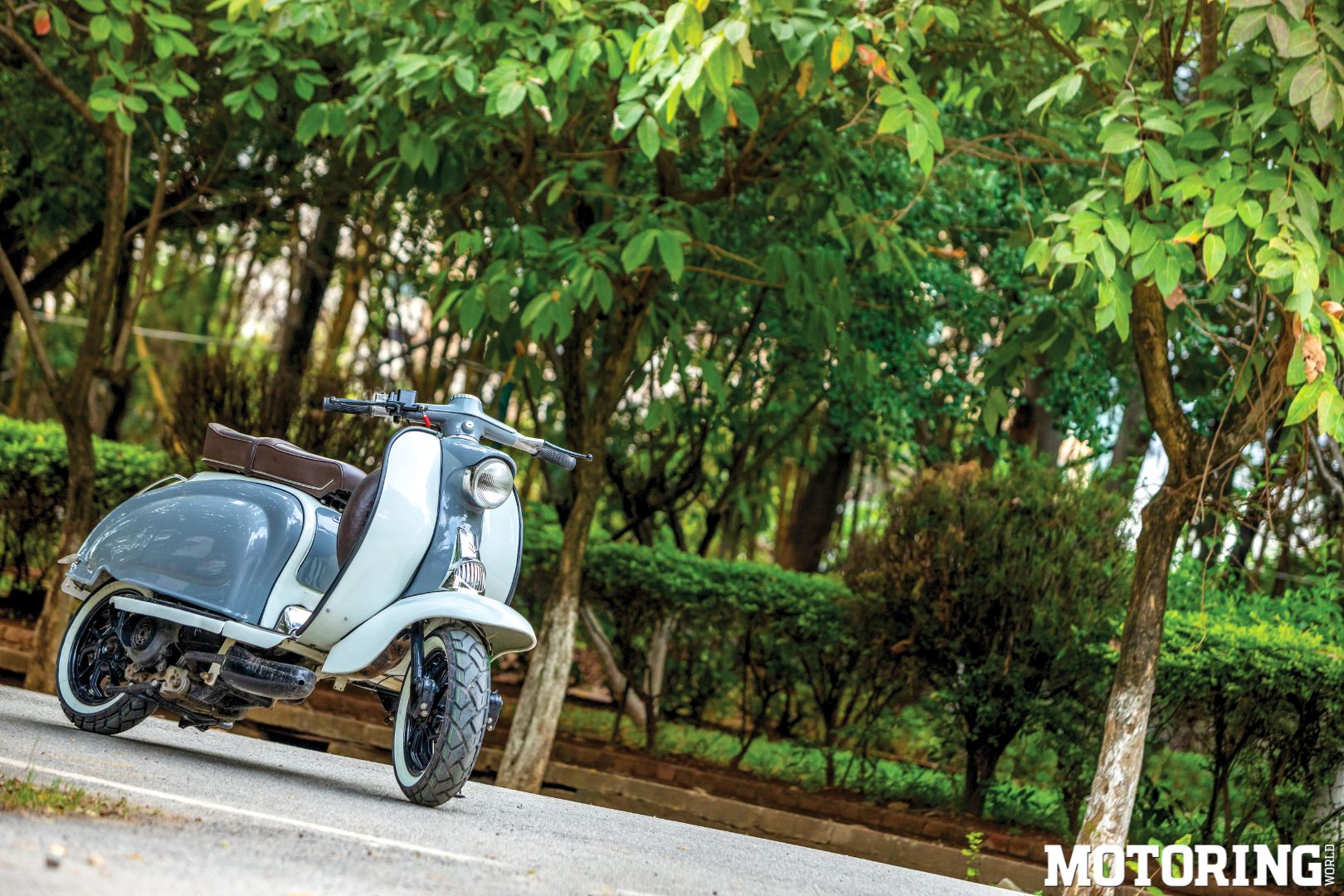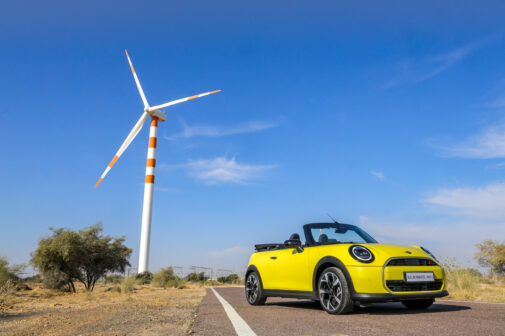Here we go again. Another engine swap for an old machine by the same guy? And exchanging a two-stroke motor for a four-stroke one?! Seems pretty blasphemous to me, especially when I know that Motomatic R&D’s primary function is to reanimate old 2T-drinkers and keep them going. Then again, what’s a rule without its exceptions? As far as unconventional ideas go, shoehorning a TVS Ntorq engine into a Lamby has to be on the higher reaches of the list titled, ‘You What?!’ I don’t even know what to call it… except the Lamby 125 4S.
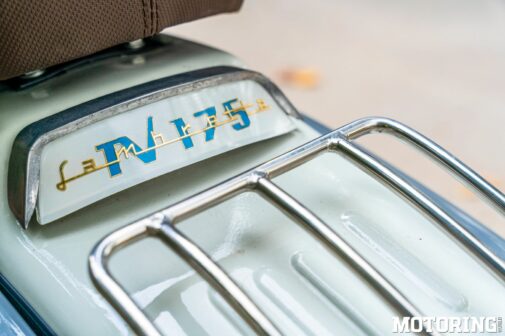
Contrary to what you may think after reading about the Fiat 1600 D and this scooter, Karan Lokhande is actually not demented. The idea for this scooter was floated by one of his clients who wanted the convenience of a twist-and-go scooter for his father, but with the retro look that was popular in the gentleman’s younger days. So the origin of this project is grounded in real-world considerations, and not born from a chaotic mind. For the latter, I have to recollect the RD 350-engined Lambretta he built in 2014. After that lunacy, the Lamby 4S seems pretty normal to me. Also, Karan wanted to build one for himself years ago, and last year he built a Vijay Super with a Suzuki Access engine for another client. This is far from his first dance, then.
Originally, the Lamby was based on the Lambretta Series 2 and was made by Automobile Products of India (API) in the 1980s. The one you see here, meanwhile, was modified to look like the Series 1, with its apron-mounted headlight, among other things. It’s running an engine from a first-gen Ntorq that was written off in a crash. He also had the options of the Access engine or one from the Aprilia scooters, but went ahead with the Ntorq’s when it presented itself; Karan prefers the 125s to the 110s because of that bit of extra power. There was no space to fit a stock airbox, so a Uni pod filter was deployed on the carb. Figuring out and installing the wiring was the biggest challenge, according to him. What a coincidence, since I have doubts about the wiring in his brain as well.
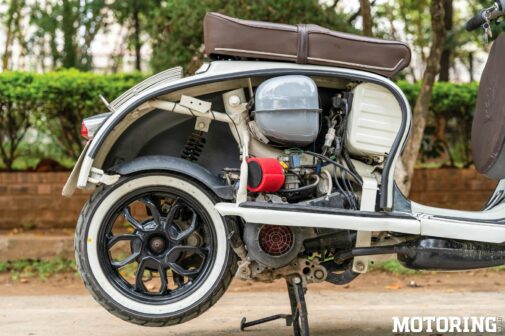
Moving on, besides the engine and wiring harness, the alloy wheels and the brake setup came from the Ntorq as well. For various reasons to do with lengths and/or fit, the telescopic fork couldn’t fit, so the front suspension was stiffened to deal with the increased weight. At the rear, the suspension is off a Kinetic Honda, again stiffened to hold up against the weight. Also, the client got the seat, badges, and 110/70 R12 Cheng Shin whitewall tyres from the UK. The tyres looked and felt quite good, even though I’d never heard of the brand before this. And, all in all, the Lamby 4S weighs somewhere between a Lambretta and an Ntorq; a stock Lamby weighed around 105 kg, and it’s the addition of the four-stroke motor that moves the needle upwards.
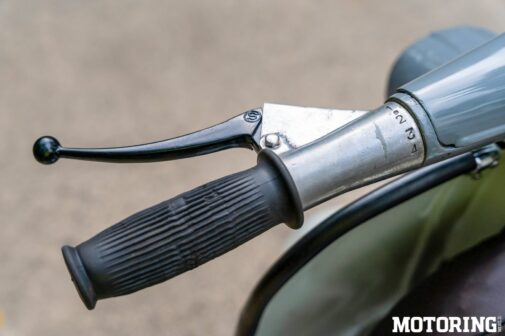
One of features I loved on the Lamby 4S was the ignition switch from a Hindustan Ambassador mounted on the handlebar. I turned it like I would in a car, and the scooter started right up with a four-stroke sound that seemed to have lost its way. That engine must wonder how it ended up there every time it wakes up, no? Once the gear-changing mechanism, the left side of the handlebar was locked into place and the lever was for the rear brake. And immediately, I understood why the son would want something like this for his father to have fun on. To ride, it definitely wasn’t as quick as an Ntorq — but it was certainly fun because of its retro charm and twist-and-go CVT. It was silent, smooth, didn’t smoke, and glided through traffic — all in comparison to a Lambretta, of course. And a stock Ntorq could never hope to have the antique charm this one does, either, so the Lamby did manage to mix the best of both worlds.
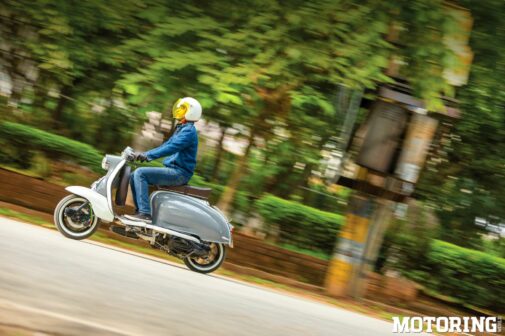
The long wheelbase meant that it was stable and confident in a straight line as well as in corners, and those fat tyres did a very good job in the latter. And it braked way better and easier than any Lambretta ever did. A short ride was enough to convince me that this idea had merit. Though I do hope Karan finds a better solution for mounting the exhaust; it looked downright hilarious up front under the floorboard. Perhaps if it were a freeflow can…

I also asked Karan if an EV based on an old scooter could be feasible — his reply, ‘I’m dying to build one!’ An EV would be much easier as well; there would be no chopping of anything, no alterations. He’d probably have to buy an EV kit or take apart an existing electric scooter. Clamps for the battery and managing weight distribution would be the biggest challenges, but otherwise it’d be pretty simple. I doubt it’d cost less than Rs 1 lakh, though, as this Lamby did, excluding the parts that the client provided. That’s reasonable enough to start putting ideas in my head, the last thing I need right now. How would classic-scooter bodywork look on an Aerox? Or perhaps a racy two-stroke conversion for an Ola, expansion chamber and all? Oh, here we go again.





